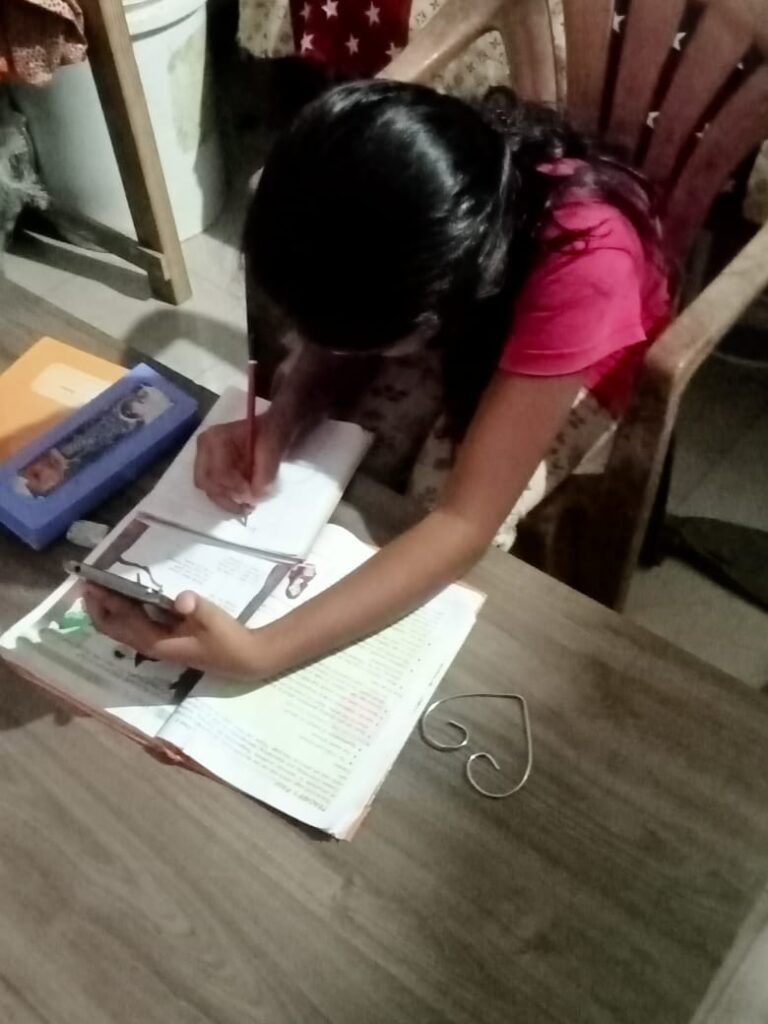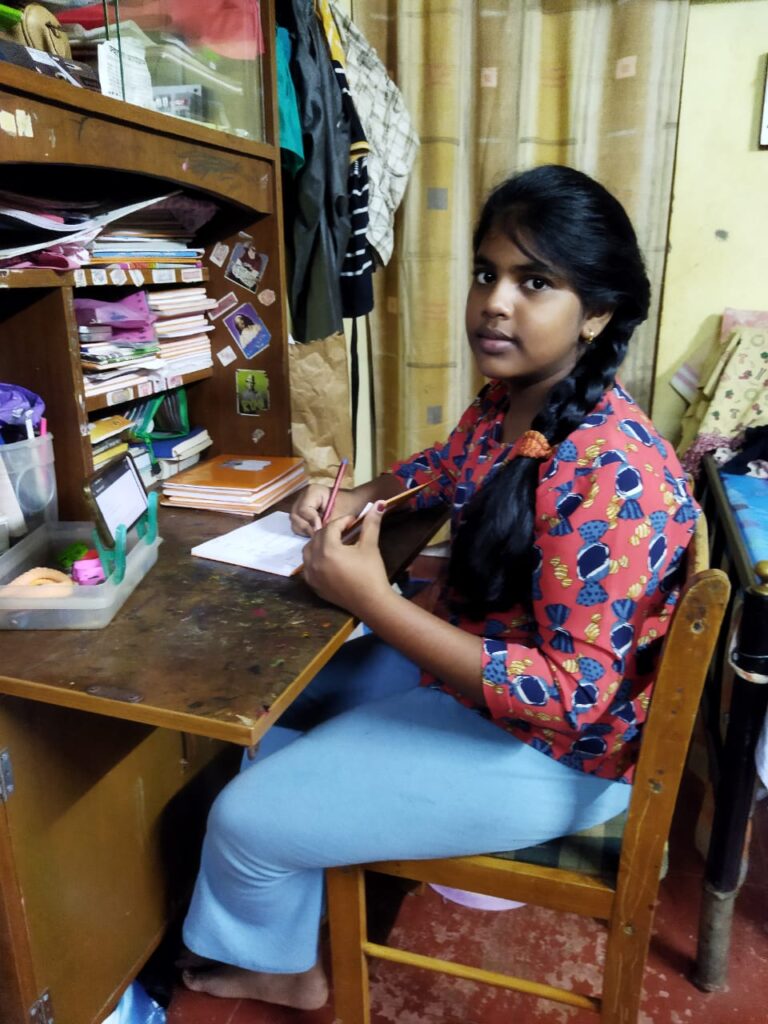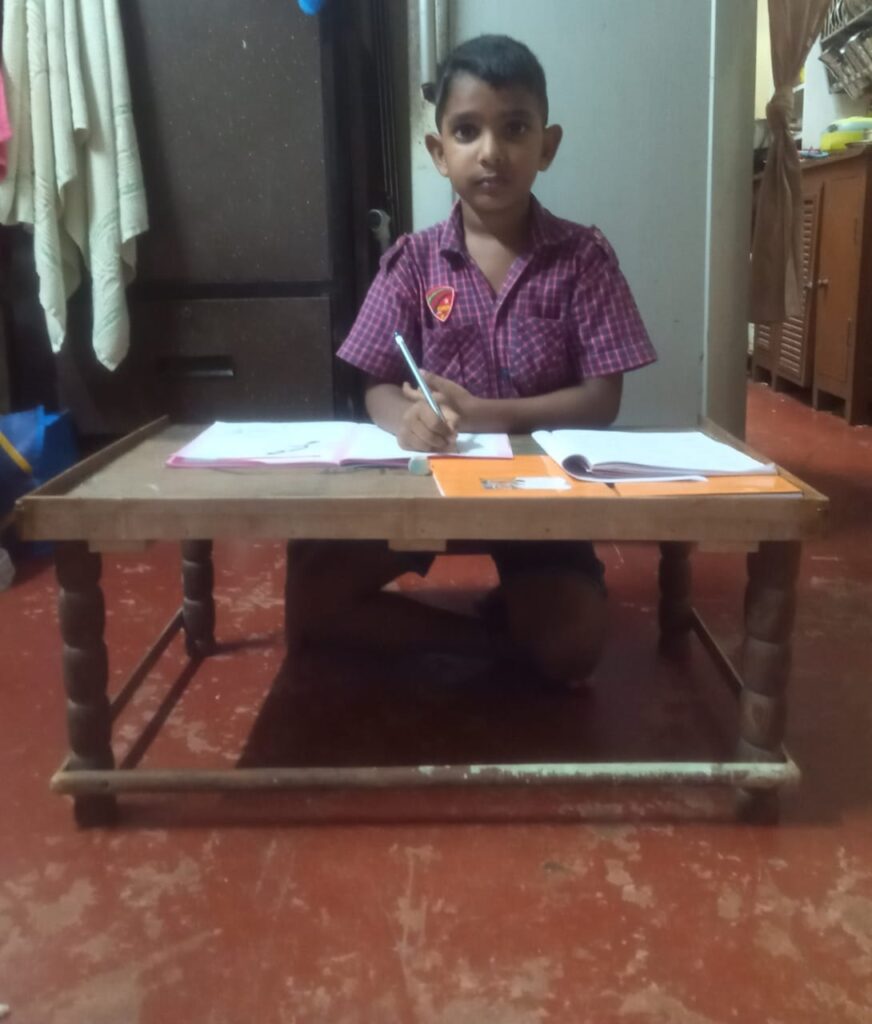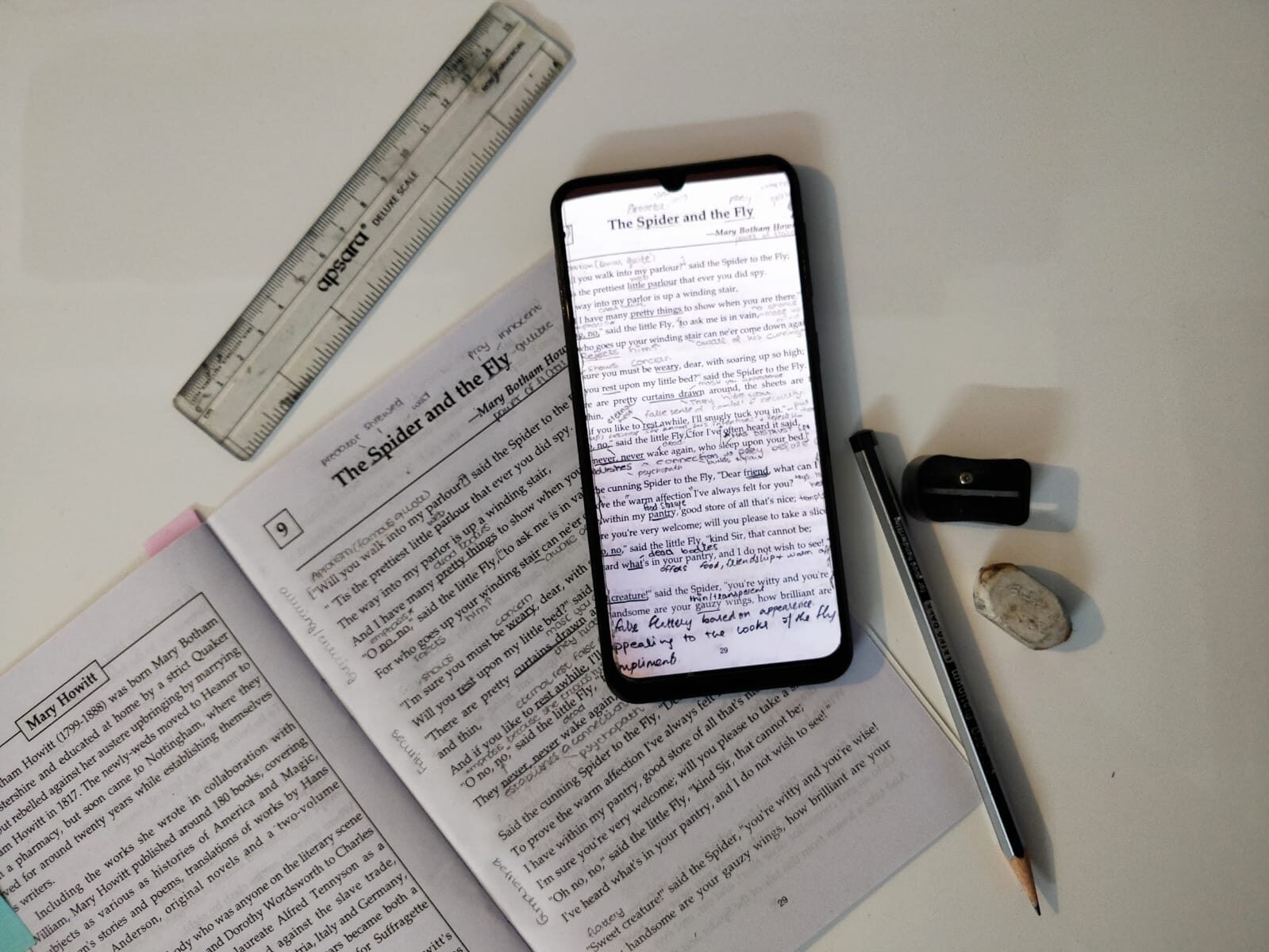Did you ever look into the space between your screen and reality? It’s hollow, dark and deep. Pay close attention and you will be surprised to hear a myriad voices from within. Listen to the chatter, in case you have not heard them loud and clear.
“I don’t hear anything the teacher is saying Mamma,” cries 11 year-old Anushka.
“Switch on and switch off the phone. The phone will be faster then.” Teacher to Shruti, a law student from a far flung Goan village.
“Ma’am, can you use your earphones? We can’t hear your voice properly”, students to the English teacher.
“Miss, I cannot put on the camera. My screen freezes every time I do,” Aditi to her class teacher Urvi.
“My eyes water when I look at the screen for a long time Naanna! What do I do?” Swati asks her father, helplessly.
“Can you adjust your camera a little, Gomti? I can only see your ceiling fan,” me to a student during online supervision.
“Sorry Miss, I couldn’t present my seminar in the class yesterday. Our family has been under quarantine and my grandmother passed away yesterday. Please excuse me miss,” Sarita on a brief call with her teacher.
June 2020. It was time for schools to reopen. But it was nothing like the earlier years. The world was coming out of its first shock and reality of the pandemic. While countries reeled under its weight, there was a section of the population which suffered the effect, quietly. School children across India suddenly found themselves without teachers, without lessons, without books and even without friends.
With no respite from the situation, the mechanism of imparting education had to change as face-to-face teaching was impossible and unsafe. There was an immediate urgency to move away from traditional classroom setup and adopt untested and unfamiliar methods of teaching. Thanks to India’s telecom revolution, the foundation for an immediate shift to online teaching was already laid. Existing resources and online platforms were gauged for usability and convenience. Some educational portals customised their applications for user-friendly teaching and learning facilities. There was a paradigm shift in the way education was perceived, dispensed and executed.
And classes started with baby steps everywhere.
However, along with the many existing social barriers and inequalities that the country is ridden with, there came about another barrier – the great digital divide. While classrooms globally have shrunk to a laptop, for millions of children across the length and breadth of India, it has further dwindled to a 6” screen.

The greater the economic divide the higher and tougher the digital barrier and smaller the screen.
Online learning opened up multiple barriers for stakeholders who are on either side of the screen – difficult dialogues, misconstrued conversations, uncomfortable silences, lapse in judgement on one hand; battered phones, technical glitches, monotonous routines, inactive lifestyle on the other.
So when Neera, a Std 3 student, studying in a government school in Taleigaon, Goa, lost her interest in studies and spent a larger part of her day playing with her neighbourhood friends, she was innocently pointing to the system that has failed to keep up its expectations. A bright and smart girl in school, after the online classes began, she gradually lost her interest in her school work. Attending classes on a phone, initially exciting, soon became a hurdle. Her parents, though they could not afford the extra financial burden, joined her for tuition to help her with her studies, but the monotony bored her and she fell into a lazy routine. “She never used to miss school even when she was ill. Now in this one year, I see so much change in her. She is always seen with her phone, watching videos with the neighbour’s children or playing with them. I cannot control her,” laments her mother Nisha, who works in 3-4 houses in that area as a cook and domestic help.
The story is the same in many homes across the country.

Anushka finishing the day’s writing work
Susheela Bhati, a 35 year old mother of a daughter and a son, complains about the difficulties of online learning. With both she and her husband out of the house almost the entire day, her children are left alone to fend for themselves. “I work as cook and my husband is a coffin maker and undertaker. My daughter who is 11 years old at least manages some lessons on her own but my 6 year old son, who is still learning to read and write, needs constant check. I am not much educated myself and after the day’s work, I have to sit with him and struggle with his daily studies.” Susheela worries that work sent on Whatsapp is difficult to copy and from the screen to the book, there are several mistakes that Anushka and Aryan make. While some schools ask parents to bring the completed books for corrections from time to time, many schools avoid doing this for fear of spread of the virus. So mistakes are repeated and carried to their exam papers as parents are not enough educated to help their children with academics.
Non-verbal communication is a very important aspect of effective learning. With no peripheral judgement because of the limitations of a mobile screen, several cue points are lost in the virtual communication. Primary and secondary education depends a lot of these non-verbal cues in absorbing and assimilating the lessons and several children find it difficult to grasp these subtle inferences. They are lost in the virtual black hole. School Counsellors have observed that children are losing hand-eye contact, longer attention span and verbal and non-verbal cues. With more phone accessibility, they are getting used to passive learning by watching videos and going through social media.

Aryan is happy to pose for a picture…a pleasant change from his routine
Most of these children are first generation learners and distance education is leaving them demotivated and worried as their care-givers cannot help them with school work. For many, the problem is also absence of an authoritative adult at home to monitor the child as parents are daily wage workers or cannot do without double income. Children are hence left in the care of grandparents or in the absence of any, find themselves alone all day.
35 year old Gauri, a Nepali migrant settled in Goa for the last many years, works as a cook. She and her husband who works as a security guard in a 5-Star hotel in Dona Paula, are away from the house practically the entire day. When schools announced online mode of teaching in 2020, she had to borrow money from her employer to buy a new phone. “I could not give him mine because I needed my phone to keep in touch with him when I go for work. My husband is out for work the entire day and I am scared to leave my son alone at home,” Gauri said. “But he is not motivated to study as there is no one at home to monitor him. He is more interested in watching videos on the phone than school work,” she added.
Nisha Pariyar mirrors the same woes as Gauri. “My 8 year old daughter didn’t even know what Instagram and Facebook were before the Covid times. She didn’t have a phone back then. But we were forced to give a phone to her for her classes but I see her on Instagram all the time which she learnt to use from an older kid in the neighbourhood.”
Bharat Amonkar, a Multitasking staff in a city college, shares his phone with his son after going back from work. His son’s school sends pre-made videos of lessons and some written work, sent on his Whatsapp by the teachers. His son watches the videos and completes the day’s work in the evening. Bharat couldn’t afford one more phone in the house and so far has been managing with just one smart phone. For those with two or more children at home, there is a constant tussle for screen space.
For joint families living in one or two rooms, home environment is not conducive for effective learning. Lack of space is a recurring complaint from many children and young adults. Mental health issues are on the rise as domestic spaces are ridden with emotional conversations, family fights, and in many cases, domestic abuse. Children, in the pre-covid times coped with these situations better as they were away in school for most of the day. Added to that is the trauma experienced by Covid 19 positive families. Children losing grandparents, parents or a family member often leave them with trauma and hopelessness. These trickle down to their studies and classes and, with an already challenging learning process, their psychological burdens are hampering their academic pursuits.
However, there are many more who are trying to make the most of the situation. Network issues and domestic difficulties take these young learners to their backyards, town suburbs, friends’ and relatives’ houses, open fields for better connectivity and in the case of some of my students, to the steps of the Central Library in Panjim for free wifi.
It is highly insensitive to leave children and the youth to bear the consequences of this existing method of education, while the nation is focussed on bringing a crippling economy back to normal.
Life on the other side of the screen is equally challenging. The shift to online mode has not been easy for thousands of educators across India. With little or no technical and digital awareness and absence of infrastructure, there was deep digital void in the stage 1 of the online teaching. In several cases, teachers were left to their own fate to buy a laptop with their own money and pay for high-speed internet connection besides struggling to learn the alien methods of teaching online. But the biggest barrier in all this is the lack of cognizance of what is happening on the other side of the screen. Besides being educators, teachers are also responsible for discipline of the child, effective learning during the class, honesty during exams and overall behaviour and development of the child. With negligible control on the child, teachers find themselves flustered, frustrated, and helpless even in cases when they are sure of the child’s indiscipline. Thus virtual classrooms in some cases have become breeding grounds for dishonesty, lies, unruliness, encouraging sometimes rude behaviour as teachers are not physically present.
“Education is at present concerned with outward efficiency, and it utterly disregards, or deliberately perverts, the inward nature of man; it develops only one part of him and leaves the rest to drag along as best it can.”
(Jiddu Krishna Murthi’s ‘Education and the Significance of Life’)
The words of this Indian philosopher and educationist resonate with the present situation and a solution to move forward is imperative. While dwindling economy is a huge concern in a country like India, a stress on education and concerns of a child are equally important. Since the biggest fear for parents and school authorities is the possible spread of virus and related health issues, solutions to placate their fears should be drawn out. As crucial as vaccination drives, are the infrastructural necessities in every school and college of the country. Decision –making of education governance ought to be given to parents, school authorities and it will certainly bring about productive and healthy dialogue about ‘how’, not ‘when’ to open schools. For starters, many schools have severe stress on basic needs like well-ventilated classrooms, clean toilets, ample place for child’s comfortable movement and good sports facilities. Diverting focus to these needs can, to a large extent, prevent health and hygiene issues. Ample supply of water in schools, maintenance of hygienic surroundings and ensuring availability of round-the-clock support staff will certainly ensure cleaner environment for a child’s health. In-house medical practitioner along with trained nurse can be appointed to monitor the child’s health. Even after the completion of an entire academic year, many educational facilities, including many urban schools and colleges, are yet to pay attention to health and hygiene factor. Basic necessities seem to be the least concern even as some states across the country are slowly opening educational institutions. E-resources are a huge asset to any educational institution but real education is in the classroom where interpersonal communication, intellectual enquiry, boosting self-esteem, confidence are infused. Without these, a child’s holistic growth and maturity cannot be achieved. Schools and colleges can be opened in a phased manner while assessing the situation carefully. This should be a priority and the only way forward. Otherwise, we will soon see a generation of children like Neera, Anushka, Aryan, Aditi, Sarita and millions more across the country with developmental needs and psychological issues.
“We are ready to work harder for our children, but we want the schools to reopen. We fear that whatever they have learnt so far, they are going to forget during these times of staying home,” Susheela says, as she and many others like her, look forward to a better tomorrow.

